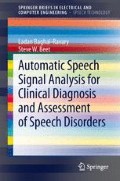Abstract
The focus of this book is the methods which have been proposed over the last 15–20 years for automatic analysis of speech to aid speech and language therapists and other skilled clinical practitioners in diagnosing and assessing speech disorders. This introductory chapter explains why it is now especially timely to develop new automatic methods, and summarises some of the features normally associated with disordered speech together with some aspects of current clinical practice. We also discuss some aspects of the current environment in which research, development, and evaluations of potential methods are performed, and the level of automation which may be expected in the near future. The importance of standardised testing data and procedures is critical in assessing technology in this field, so the availability of suitable testing data is discussed.
Access this chapter
Tax calculation will be finalised at checkout
Purchases are for personal use only
Notes
- 1.
KayPENTAX® Disordered Voice Database and Program, Model 4337 includes their Multi-Dimensional Voice Program (MDVP™) and the Computerized Speech Lab (CSL™)/Multi-Speech™ software. Further information can be found on their web site (http://www.kaypentax.com/).
References
Abou-Elsaad T (2010) Auditory perceptual assessment of voice and speech disorders. In: Presentation at the 28th Alexandria international congress (Comb ORL). http://alexorl.com/page/The28thAlexandriaInternationalCongress(Combined%20ORL). Accessed 16 Feb 2012
Cummings L (2008) Clinical linguistics. Edinburgh University Press Ltd, Edinburgh. ISBN 978 0 7486 2077 7
Deller JR, Liu MS, Ferrier LJ, Robichaud P (1993) The Whitaker database of dysarthric (cerebral palsy) speech. J Acoust Soc Am 93(6):3516–3518. doi:10.1121/1.405684
Duffy JR (2011) Differential diagnosis among the dysarthrias—the rules of the game. In: Presentation at the Texas speech-language-hearing association 2011 Convention. http://www.txsha.org/convention/handouts2011.aspx. Accessed 16 Feb 2012
Fairbanks G (1960) Voice and articulation drillbook, 2nd edn. Harper & Row, New York, pp 124–139
Hawley MS, Green PD, Enderby P, Cunningham SP, Moore RK (2005) Speech technology for e-inclusion of people with physical disabilities and disordered speech. In Proceedings of INTERSPEECH-2005, pp 445–448
Kim H, Hasegawa-Johnson M, Perlman A, Gunderson J, Huang T, Watkin K, Frame S (2008) Dysarthric speech database for universal access research. In Proceedings of INTERSPEECH-2008, pp 1741–1744
Koreman J, Pützer M (2003) The usability of perceptual ratings of voice quality. In: Proceedings of 6th international conference: advances in quantitative laryngology, voice and speech research (AQL 2003)
Maier A, Haderlein T, Eysholdt U, Rosanowski F, Batliner A, Schuster M, Nöth E (2009) PEAKS—a system for the automatic evaluation of voice and speech disorders. Speech Commun 51(5):425–437. doi:10.1016/j.specom.2009.01.004
Mehta DD, Hillman RE (2008) Voice assessment: updates on perceptual, acoustic, aerodynamic, and endoscopic imaging methods. Curr Opin Otolaryngol Head Neck Surg 16(3):211–215. doi:10.1097/MOO.0b013e3282fe96ce
Menéndez-Pidal X, Polikoff JB, Peters SM, Leonzio JE, Bunnell HT (1996) The Nemours database of dysarthric speech. In: Proceedings of 4th international conference on spoken language processing (ICSLP), vol 3, pp 1962–1965. doi:10.1109/ICSLP.1996.608020
Pützer M, Koreman J (1997) A German database of patterns of pathological vocal fold vibration. PHONUS 3:143–153
Saz O, Lleida E, Vaquero C, Rodríguez WR (2010) The Alborada-I3A corpus of disordered speech. In: Proceedings of language resources and evaluation conference LREC-2010, pp 2814–2819
Shriberg LD (1994) Five subtypes of developmental phonological disorders. Clinics in Commun Disord 4:38–53
Tversky A (1969) Intransitivity of preferences. Psychol Rev 76:31–48. doi:10.1037/h0026750
Yin S-C, Rose R, Saz O, Lleida E (2009) A study of pronunciation verification in a speech therapy application. In Proceedings of IEEE international conference on acoustics, speech, and signal processing ICASSP-2009, pp 4609–4612
Author information
Authors and Affiliations
Corresponding author
Rights and permissions
Copyright information
© 2013 The Author(s)
About this chapter
Cite this chapter
Baghai-Ravary, L., Beet, S.W. (2013). Introduction. In: Automatic Speech Signal Analysis for Clinical Diagnosis and Assessment of Speech Disorders. SpringerBriefs in Electrical and Computer Engineering(). Springer, New York, NY. https://doi.org/10.1007/978-1-4614-4574-6_1
Download citation
DOI: https://doi.org/10.1007/978-1-4614-4574-6_1
Published:
Publisher Name: Springer, New York, NY
Print ISBN: 978-1-4614-4573-9
Online ISBN: 978-1-4614-4574-6
eBook Packages: EngineeringEngineering (R0)

